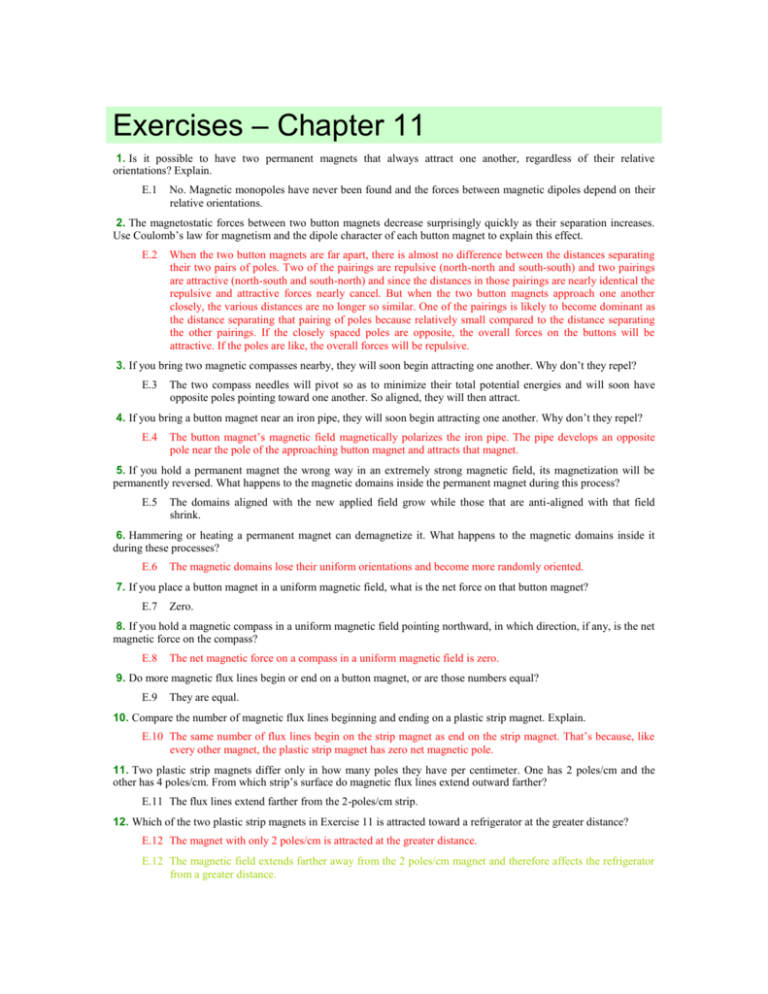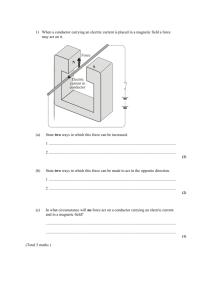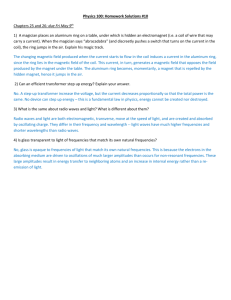Exercises – Chapter 11
advertisement

Exercises – Chapter 11 1. Is it possible to have two permanent magnets that always attract one another, regardless of their relative orientations? Explain. E.1 No. Magnetic monopoles have never been found and the forces between magnetic dipoles depend on their relative orientations. 2. The magnetostatic forces between two button magnets decrease surprisingly quickly as their separation increases. Use Coulomb’s law for magnetism and the dipole character of each button magnet to explain this effect. E.2 When the two button magnets are far apart, there is almost no difference between the distances separating their two pairs of poles. Two of the pairings are repulsive (north-north and south-south) and two pairings are attractive (north-south and south-north) and since the distances in those pairings are nearly identical the repulsive and attractive forces nearly cancel. But when the two button magnets approach one another closely, the various distances are no longer so similar. One of the pairings is likely to become dominant as the distance separating that pairing of poles because relatively small compared to the distance separating the other pairings. If the closely spaced poles are opposite, the overall forces on the buttons will be attractive. If the poles are like, the overall forces will be repulsive. 3. If you bring two magnetic compasses nearby, they will soon begin attracting one another. Why don’t they repel? E.3 The two compass needles will pivot so as to minimize their total potential energies and will soon have opposite poles pointing toward one another. So aligned, they will then attract. 4. If you bring a button magnet near an iron pipe, they will soon begin attracting one another. Why don’t they repel? E.4 The button magnet’s magnetic field magnetically polarizes the iron pipe. The pipe develops an opposite pole near the pole of the approaching button magnet and attracts that magnet. 5. If you hold a permanent magnet the wrong way in an extremely strong magnetic field, its magnetization will be permanently reversed. What happens to the magnetic domains inside the permanent magnet during this process? E.5 The domains aligned with the new applied field grow while those that are anti-aligned with that field shrink. 6. Hammering or heating a permanent magnet can demagnetize it. What happens to the magnetic domains inside it during these processes? E.6 The magnetic domains lose their uniform orientations and become more randomly oriented. 7. If you place a button magnet in a uniform magnetic field, what is the net force on that button magnet? E.7 Zero. 8. If you hold a magnetic compass in a uniform magnetic field pointing northward, in which direction, if any, is the net magnetic force on the compass? E.8 The net magnetic force on a compass in a uniform magnetic field is zero. 9. Do more magnetic flux lines begin or end on a button magnet, or are those numbers equal? E.9 They are equal. 10. Compare the number of magnetic flux lines beginning and ending on a plastic strip magnet. Explain. E.10 The same number of flux lines begin on the strip magnet as end on the strip magnet. That’s because, like every other magnet, the plastic strip magnet has zero net magnetic pole. 11. Two plastic strip magnets differ only in how many poles they have per centimeter. One has 2 poles/cm and the other has 4 poles/cm. From which strip’s surface do magnetic flux lines extend outward farther? E.11 The flux lines extend farther from the 2-poles/cm strip. 12. Which of the two plastic strip magnets in Exercise 11 is attracted toward a refrigerator at the greater distance? E.12 The magnet with only 2 poles/cm is attracted at the greater distance. E.12 The magnetic field extends farther away from the 2 poles/cm magnet and therefore affects the refrigerator from a greater distance. 13. How could you use iron to prevent the magnetic flux lines from a strong button magnet from extending outward into the room? E.13 Encase the magnet in an iron box. The iron will then guide the flux lines. 14. To keep the strong magnets in a scientific facility next door from sending flux lines through your office, should you line the office walls with aluminum or with iron? E.14 Iron. E.14 Iron is a soft ferromagnetic material and will attract the flux lines and direct them through itself. Aluminum is nonmagnetic and will essentially ignore the magnetic flux lines. 15. Your friends are installing a loft in their room and are using thin speaker wires to provide power to an extra outlet. If they draw only a small amount of current from the outlet, the voltage drop in each of the wires will remain small. Why? E.15 The voltage drop in each wire is proportional to the current. 16. When your friends from Exercise 15 plug a large home entertainment system into the outlet, it doesn’t work properly because the voltage rise provided by the extra outlet is only 60 V. The power company provides a voltage rise of 120 V, so where is the missing voltage? E.16 The voltage was lost in the wires as the current passed through them. 17. A particular lightbulb is designed to consume 40 W when operating on a car’s 12-V DC electric power. If you supply that bulb with 12-V AC power from a transformer, how much power will it consume? E.17 It will consume 40 W. 18. Your toaster consumes 800 W when operating on 120-V AC electric power. If your rugby team is camping and all of you string together flashlight batteries to supply that toaster with 120-V DC electric power, how much power will it consume? E.18 800 W. 19. To read the magnetic strip on an ID or credit card, you must swipe it quickly past a tiny coil of wire. Why must the card be moving for the coil system to read it? E.19 Only a moving magnet or changing magnetic field will produce the electric field necessary to push currents through coil inside the playback head. 20. One type of microphone has a permanent magnet and a coil of wire that move relative to one another in response to sound waves. Why is the current in the coil related to the motion? E.20 As the coil moves through the magnetic field, its mobile electric charges experience the Lorentz force and therefore flow through the coil as an electric current. If the coil is part of a circuit, the current it experiences will probably be proportional to its velocity through the magnetic field. 21. If the primary coil of a transformer has 200 turns and is supplied with 120-V AC power, how many turns must the secondary coil have to provide 12-V AC power? E.21 20 turns. 22. The transformer supplying power to an artist’s light sculpture provides 9600-V AC when supplied by 120-V AC. If there are 100 turns in the transformer’s primary coil, how many turns are there in its secondary coil? E.22 8000 turns. 23. The primary coil of a transformer makes 240 turns around the iron core, and the secondary coil of that transformer makes 80 turns. If the primary voltage is 120-V AC, what is the secondary voltage? E.23 40-V AC. E.23 The ratio of the secondary turns to primary turns is 1 to 3, so the ratio of the voltage rise in the secondary to the voltage drop in the primary is also 1 to 3. That means that if the primary voltage drop is 120 V, the secondary voltage rise is 40 V. 24. The transformer in a stereo amplifier has a primary coil with 200 turns and a secondary coil with 40 turns. When the primary coil is supplied with 120-V AC, what voltage does the secondary coil provide? E.24 24-V AC. 25. If an average current of 3 A is passing through the primary coil of the transformer in Exercise 23, what average current is passing through the secondary coil of that transformer? E.25 9 A. 26. If the average current passing through the secondary coil of the transformer in Exercise 24 is 10 A, what average current is passing through the primary coil? E.26 2 A. 27. A magnet hanging from a spring bounces in and out of a metal ring. Although it doesn’t touch the ring, the magnet’s bounce diminishes faster than it would if the ring weren’t there. Explain. E.27 The bouncing magnet heats the ring by inducing current in it. That current extracts this heating energy from the magnet by exerting magnetic forces on it and doing negative work on it. 28. The high-voltage spark that ignites gasoline in a basic lawn mower engine is produced when a magnetic pole moves suddenly past a stationary coil of wire. From where does that spark’s energy come? E.28 The energy is extracted from the moving magnetic pole. 29. If you have a coil of wire, a battery, a magnetic compass, and an electrical switch, how could you make the compass needle spin? E.29 Form a circuit from the coil, battery, and switch and close the circuit briefly each time the compass needle reaches anti-alignment with the coil’s field. 30. If you circle a permanent magnet around a magnetic compass, the compass needle will follow along. What is providing the needle with the energy it needs to continue turning despite friction in its pivot? E.30 You and your moving permanent magnet are doing work on the needle to keep it rotating despite the friction it experiences. 31. You can’t make a motor using only permanent magnets. Why not? E.31 The magnets will all eventually orient themselves in the minimum energy configuration and never move again. 32. You can’t make a motor using direct current and electromagnets that doesn’t require switches. Why not? E.32 Without any switchable magnets, the motor’s rotor will accelerate in the direction that minimizes its total potential energy. After a brief period of oscillating back and forth, it will settle down and never move again. To continue moving, it needs switchable magnets, which also provide the power needed to keep the rotor moving against the slowing forces of friction or moving whatever is attached to the motor. 33. If you double the DC voltage supplied to a DC motor, what will happen? E.33 The rotor’s rotation speed will double. 34. If you double the AC voltage supplied to a synchronous AC motor, what will happen? E.34 The rotor’s rotation speed will remain unchanged (although the motor may overheat). 35. If you supply AC voltage to a brushed DC motor, what will happen? E.35 The rotor will vibrate but will not spin. 36. If you supply DC voltage to a synchronous AC motor, what will happen? E.36 The rotor may oscillate briefly, but it will soon stop moving and not move again. 37. Some decorative lightbulbs have a loop-shaped filament that jitters back and forth near a small permanent magnet. The filament wire itself isn’t magnetic, so why does the filament move when alternating current flows through it? E.37 Current in a magnetic field experiences the Lorentz force and bends the filament back and forth. 38. If a flexible wire carrying 60-Hz alternating current runs through the gap between a north and south magnetic pole, what will happen to that wire? E.38 The wire will experience forces perpendicular to its length and to the line separating the two poles. It will probably vibrate back and forth as a result, in synchrony with the alternating current and thus at a frequency of 60 Hz. 39. Suppose you include an inductor in an electric circuit that includes a battery, a switch, and a lightbulb. Current leaving the battery’s positive terminal must flow through the switch, the inductor, and the lightbulb before returning to the battery’s negative terminal. The current in this circuit increases slowly when you close the switch, and it takes the lightbulb a few seconds to become bright. Why? E.39 The inductor opposes changes in current and slows the rise in current that occurs when you close the switch. 40. When you open the switch of the circuit in Exercise 39, a spark appears between its two terminals. As a result, the circuit itself doesn’t open completely for about half a second, during which time the bulb gradually becomes dimmer. The bulb’s behavior indicates that the current in the circuit diminishes slowly, rather than stopping abruptly when you open the switch. Why does the current diminish slowly? E.40 The inductor opposes changes in current and it slows the fall in current that occurs when you open the switch. 41. A television picture tube produces its images using beams of electrons that move through empty space and strike phosphors on the inside of the screen. Those phosphors glow following the impact. But aiming the electron beams is a delicate task. Why is it important to avoid placing strong magnets near a television picture tube? E.41 The electron beams will be deflected by Lorentz forces as they pass through the stray magnetic fields from those magnets. 42. Audio speakers produce motion and ultimately sound by passing fluctuating currents through wires immersed in magnetic fields. Why would this arrangement result in motion and why is it important not to put audio speakers too close to a television picture tube (Exercise 41)? E.42 Current flowing through wires in a magnetic field experiences the Lorentz force. That force moves the entire wire, pushing it back and forth in synchrony with the current fluctuations in the wire. The strong magnetic field near a speaker would also affect the charges moving inside a television picture tube and would cause them to strike the wrong area of the screen. To keep the television image pure, the picture tube must be protected from stray magnetic fields.








